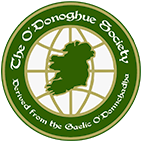native of County Cavan, Ireland, James P. O’Donoghue was delivered into the world on the first of May 1876. He studied at All Hallows Seminary in Dublin but it was not until he came to America in 1903 that he completed the study for the priesthood. After graduation from St. Paul Seminary at St. Paul, Minnesota, he settled in Chicago. He was ordained on Pentecost Sunday, June 11, 1904, at Chicago’s Holy Name Cathedral. After ordination Father O’Donoghue served as assistant at St. Columbkille, St. Mary’s in Rockford, back to Chicago and ‘old’ St. Patrick’s, then to St. Veronica’s Church.
Only at St. Dennis but five short years, Father O’Donoghue’s days were very productive and fulfilling. He was true to his Irish roots and reveled in the spirit of St. Patrick at the annual banquet honoring the Irish patron saint. The "New World" of March 13, 1925, noted that besides the guest speaker, the Reverend Hugh P. Smythe, former pastor at St. Patrick’s in Lemont, the novelty of the program was the "playing of the Irish war pipes by Mr. John McKenna." The evening was spent in the enjoyment of Irish melodies played upon the pipes.
Having proved himself a dynamic pastor Father O’Donoghue was rewarded with the assignment as pastor of one of Chicago’s most renowned churches of the time, St. James Church at 29th Street and Wabash Avenue.
As the Second World War raged Father O’Donoghue moved to St. Killian’s on July 3, 1942. He was there five years. Father James P. O’Donoghue passed away on the second of August 1947, in the St. Killian rectory following a year of lingering illness. Four sisters and one brother attended the solemn High Mass given in his honor. Two of his sisters were nuns of the Order of Providence. Cardinal Stritch eulogized this priest who, like so many before him, made the transatlantic journey to minister in the New World. Among the priests acting as assistants for the cardinal was Reverend Michael Mugan, pastor of St. Dennis Church at the time of Father O’Donoghue’s death.
